South Edinburgh Service Resilience (2018)
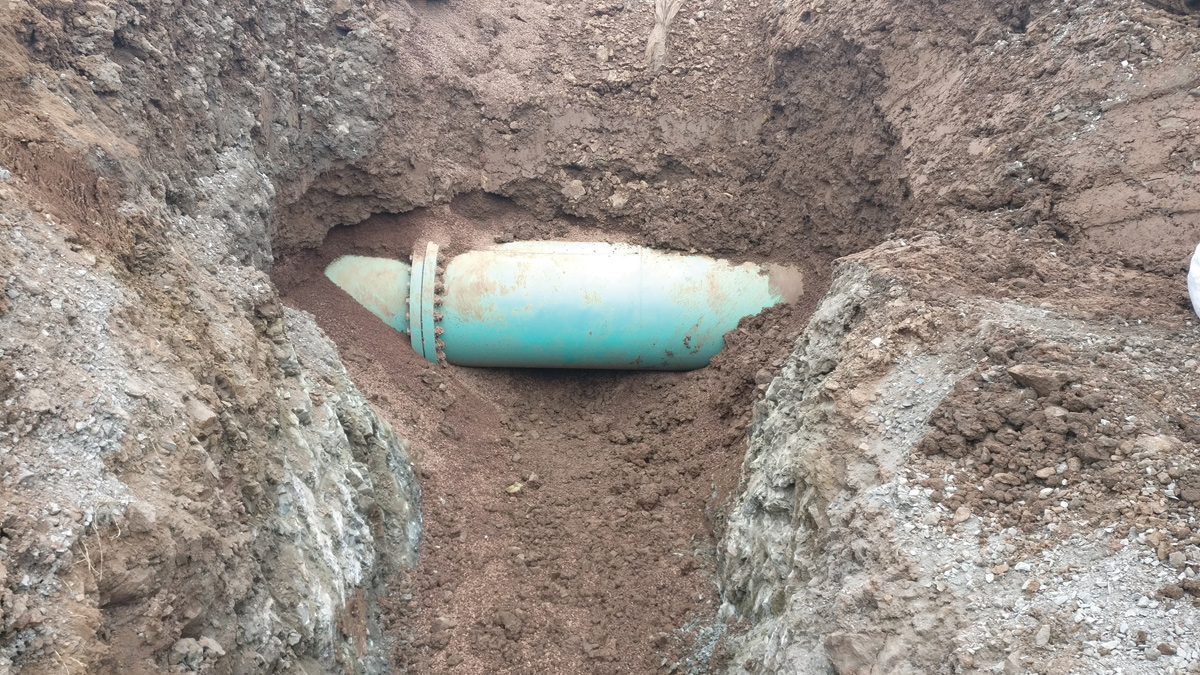
Existing main in situ - Courtesy of Caledonia Water Alliance
Caledonia Water Alliance (CWA) has been tasked with improving the water infrastructure network within Edinburgh and the Lothians, in partnership with Scottish Water. The Scottish Water project driver is CS16WR for Water Systems Resilience; associated with improving resilience of network supply. The project objective is to provide resilience in the wider water distribution network linked directly to two existing water treatment works (WTWs) located south of Edinburgh. The scope of work includes installation of over 5km of twin 800mm diameter and over 6km of 630mm diameter ductile iron (DI) pipelines south of the Edinburgh City Bypass. The pipelines are bi-directional, providing resilience for two operational water treatment plants. In addition, the ‘business as usual’ case facilitates the re-zoning of two existing distribution service reservoirs (DSRs) and the decommissioning of an existing pumping station. Once complete, this £multi-million investment project in the clean water network will ensure resilient water supplies to more than 165,000 Scottish Water customers, both residential and commercial.
Pipeline design
Development of the engineering design to determine the most hydraulically advantageous route for pipe laying works was completed by August 2017, with the pipeline route finalised. Various pipeline material options were considered and a final decision was taken to install DI mains. Optioneering confirmed that DI was the most cost effective option and the material resolved issues with high pressures during resilience events. The planned twin 800mm diameter mains connect into existing twin 1,200mm diameter Polyethylene (PE) mains and are designed to transfer flows of up to 90Ml/d, supporting the resilience of supply flows within the network.
During the construction phase, pipework connections to the existing 1,200mm diameter PE mains will be challenging. The connections were originally planned to be completed as live under-pressure connections, with the intention of reducing the risk of affecting supply to Scottish Water’s customers. However, following a number of design meetings and consultations, the final decision on the subject was that under-pressure connections were deemed not to be the best way to proceed on this project due to the size of the pipes involved and the associated risk level being deemed too high.
Also, the connection point location was re-assessed and a more suitable location identified upstream of the existing bypass valves which would permit normal service supply to continue with minimal disruption. This option, would allow connection works to be completed overnight when demand is lower and supplies can be diverted; with one main supporting supply whilst the other main undergoes a full overnight shutdown. This section of the works is where the biggest risk to project success lies. Construction has now commenced, with the first connection installed and completed, by advanced instruction, during June 2018.
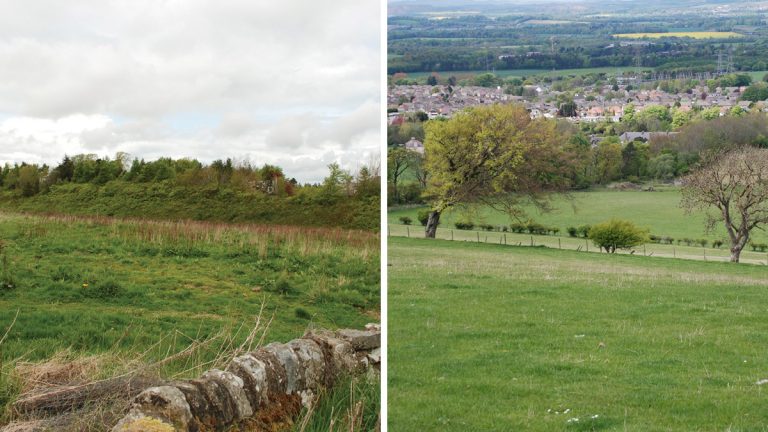
(left) Pumping station site and (right) rural landscape – Courtesy of Caledonia Water Alliance
In addition to installation of the DI pipework, there will be requirement to design and construct a secure facility to house temporary pumps, which will be mobilised should a resilience event occur at one of the WTW locations. The works will comprise formation of a base slab, installation of connection pipework for the pumps, formation of an access track and installation of secure fencing around the perimeter of the site. No permanent building structures are planned at this site, therefore reducing associated environmental and/or visual impacts. There is also the added benefit of a saving in the whole-life operating and maintenance costs by adopting this approach. To support the ‘business as usual case’ at one of the WTW locations, a gravity solution will be adopted. A sympathetic landscape design has been created to reduce the visual impact of the facility and planning permission has been granted for the works on this basis.
Engineering constraints & challenges
Throughout the design and construction works, there are a variety of engineering challenges to be overcome including the proximity to overhead power cables, existing high pressure gas mains and various other utility services in the vicinity; as identified as part of a suite of desktop risk assessments and site walkovers. At some points along the planned pipeline route, there will be a requirement for works to be undertaken directly below live overhead power lines. Affected utility companies have been consulted and their requirements are being considered for construction to mitigate any risk to the assets, and to ensure safe working practices for construction operatives, landowners and the public.
Design challenges also included multiple major and minor road, access track and watercourse crossings. The pipeline design incorporates a trenchless road crossing of the A702 Biggar Road by tunnelling method and approximately 8-10 minor rural road and/or farm track crossings. Ground investigation data is essential for the design of tunnelled sections beneath proposed motorway and major road crossings. Consultations with Transport Scotland are fully engaged in relation to the proposed tunnel crossing of the A702 Biggar Road. In addition, there is a planned crossing of the Harlaw Burn, which runs through a deeply incised channel; this crossing is to be completed using a horizontal directional drilling technique.
Another key constraint arose due to the identification of historical ordinance found during the Unexploded Ordinance Survey of a nearby military training area. As a result, agreement was reached that a full clearance operation to remove all unexploded ordinance in the affected area was necessary, to ensure the safety of the works as they progress to construction. The findings of the Unexploded Ordinance Survey initiated some necessary design alterations to the route, whereby realigning the pipeline route to follow the area planned for full ordinance clearance.
The Unexploded Ordinance Survey was completed in April 2017; coordinated and undertaken by specialist contractor, Dynasafe BACTEC Ltd. (Dynasafe). Dynasafe offer specialist Battle Area Clearance, Training, Equipment and Consultancy services in relation to unexploded ordinance risk mitigation.
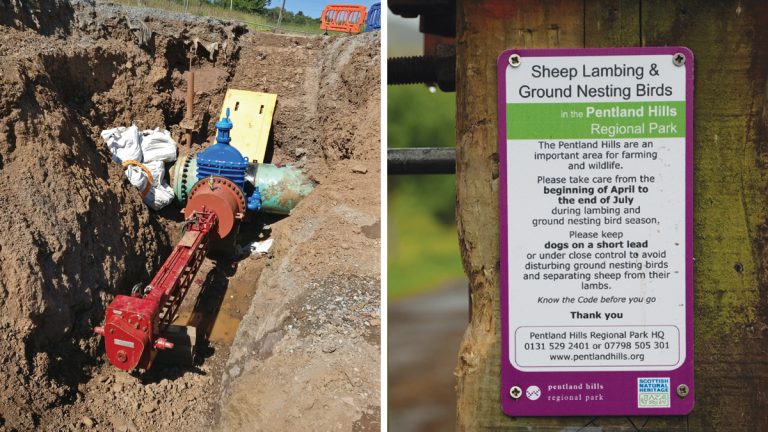
(left) New connection on existing main and (right) Pentland Country Park animal notice – Courtesy of Caledonia Water Alliance
The proximity of the works to historical WWI practice trenches was a principal concern; to alleviate this, an Archaeological Watching Brief was implemented during site investigation works by specialist contractor, Archas Cultural Heritage Ltd. (Archas) to ensure any risk to local history was properly mitigated and local heritage protected, where possible. Now that construction has started, Archas has been engaged to continue with the watching brief during the construction period to ensure that any archaeological remains are located and recorded. The Local Authority’s Archaeology Department is also engaged in this exercise to ensure that Scottish Water is compliant with current legislation, in terms of archaeological reporting.
Constraints identified as part of site walkover survey and initial ground investigation works include the existing ground conditions, noted to be of hilly terrain with extensive areas of shallow igneous bedrock below the ground surface particularly to the west of the site; which could pose potential issues with the planned hydraulic model profile and construction approach. As part of the pre-construction site investigation works, the site investigation contract was completed by Environmental Scientifics Group Ltd, (ESG), in April 2017. A LiDAR Survey was also completed, with the information obtained then utilised to build a detailed design model and hydraulic profile of the overall project.
Environmental constraints & challenges
Environmental issues have also been identified, which will have an impact, albeit indirectly, on the construction phase.
Part of the planned pipeline route crosses the Pentland Hills Regional Park and the Swanston Conservation Area, where any works undertaken during April and the end of July must take extra care and consideration due to lambing season and ground nesting birds, and environmental considerations in this region are paramount. Planning permission is required to cross the Swanston Conservation Area; this permission is now in place. Within the Pentland Hills Regional Park, Dreghorn Woods has been designated by Woodland Trust Scotland as a First World War Centenary Wood. The park must be kept open to the public at all times during construction and measures have been taken to allow to walkers and cyclists etc. to access the park.
A select number of trees are being removed to allow installation of the pipeline hence a specialist arborist has been appointed to determine which trees can be taken down and the safest way to do so. Linked to the tree removal, is the implementation of a specialist monitoring programme of identified trees to check for any presence of nesting birds. If nesting birds are discovered, tree removal will be halted until the end of the nesting season.
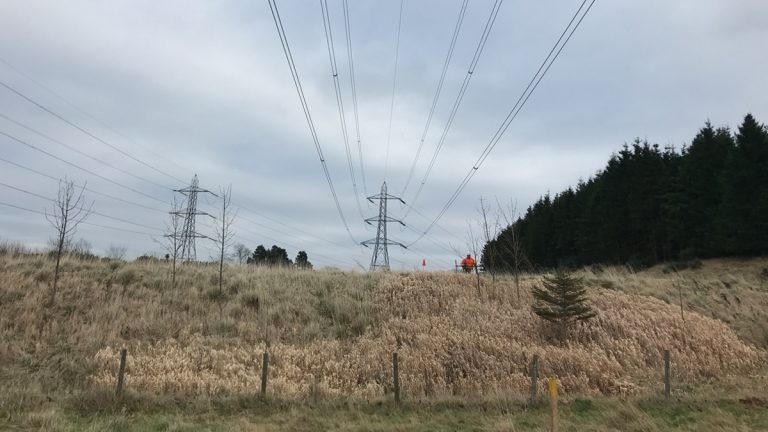
Embankment (MoD property) – Courtesy of Caledonia Water Alliance
There are concerns over the proximity of a badger sett; the location is beyond the periphery of the planned construction area, however, precautions will have to be taken to minimise the risk of endangering any badgers or their habitat.
In the vicinity of the construction area, invasive species of Giant Hogweed and Japanese Knotweed have been identified; to ensure construction works do not spread these species; a process will be implemented for thorough cleaning of all construction plant and equipment, and monitored accordingly. Infected areas in close proximity to the construction works have been fenced off to reduce the risk of invasive species being spread inadvertently by passing vehicles or site personnel.
Burns and streams run nearby the planned route, which are potentially salmonid waters, therefore construction works will take account of salmon spawning season. SEPA are fully engaged in the project to ensure compliance with legislation and obtaining licences to work. SEPA will also provide watching brief services to the project.
Communication is key
The interface with local businesses and sporting activities in the area potentially affected by the planned works is a key aspect to this project’s success. CWA’s Customer Care and Scottish Water’s Land Liaison Teams have invested a considerable amount of time and effort to resolve interface issues to date. Meetings with landowners and land agents are held regularly to ensure continuity of communications related to the project and progress updates, and to help smooth the way leading up to and during the construction phase.
The finalised pipeline route has been discussed with all affected landowners, with any concerns raised taken on board and incorporated into the design to minimise the associated impact(s) on their business operations. Through extensive and continued communications we aim to address and, where possible, limit the impact of the works on business and leisure activities, while working to planned timescales and budget.
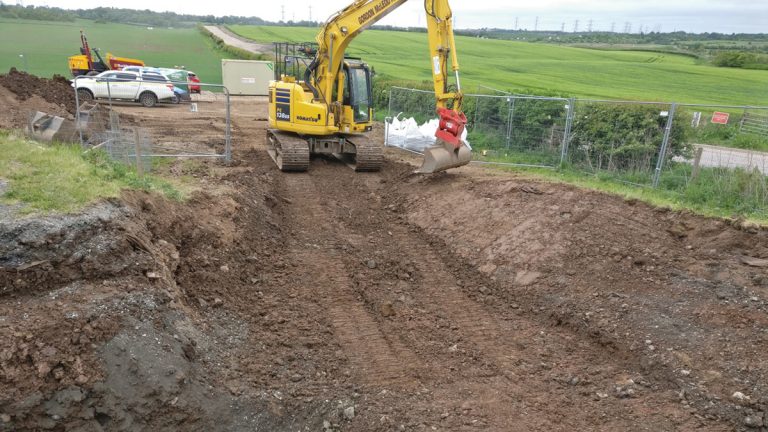
Excavation Works on Existing Main – Courtesy of Caledonia Water Alliance
Progress to date
The resilience project was approved for construction by the Scottish Water Board in February 2018, with the start of construction approved for 26 March 2018. Construction is now in the preparation stages with tree cutting, fencing and planning ongoing.
The detailed design stage is complete and the final drawings for construction prepared. A construction schedule with an updated timeline incorporating the identified constraints arising to date whilst maintaining the desired future key milestone completion dates has been compiled. The schedule highlights our progress to date, and the planned path throughout the construction stage.
CWA are working hard on site to self-deliver a fit for purpose design and progress the project to completion, providing as many savings as possible for Scottish Water on the overall project cost.
The construction phase site compound set-up is planned for mid-July 2018, with archaeological trial digs due to start towards the end of July. Following this, construction work will begin to pick up pace, with rapid progress for easement topsoil stripping to enable pipe laying operations to commence.
If current planned timescales are adhered to, then the project will remain on target for our anticipated completion of the construction phase, meeting Scottish Water’s project completion deadline of March 2020.



